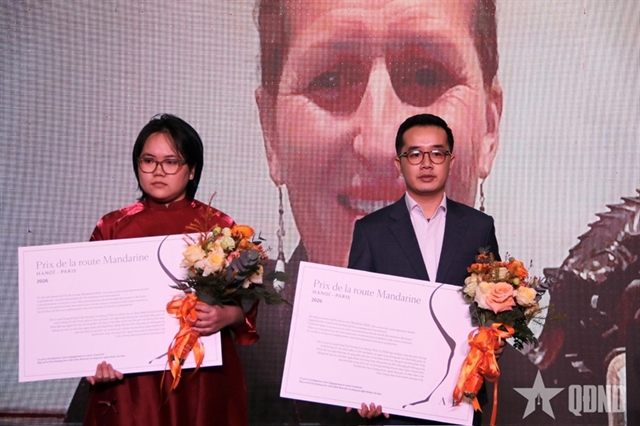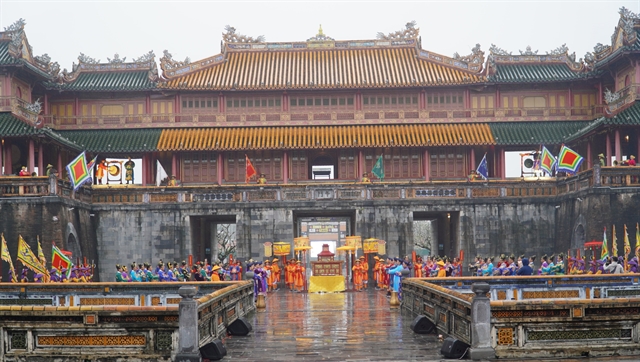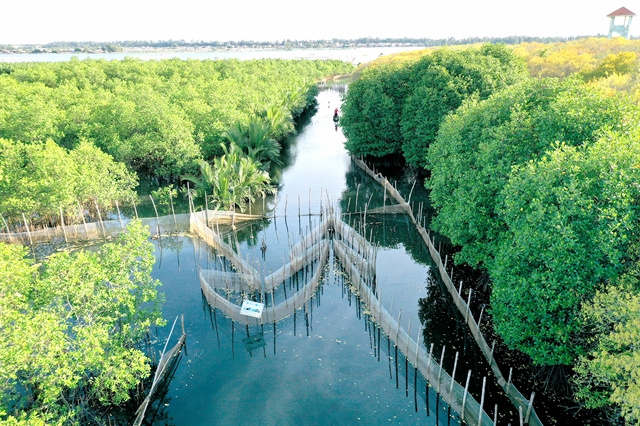 Society
Society

 |
| A festival event is organised in Huế City of Thừa Thiên-Huế Province. The province plans to be a key economic urban area in central Việt Nam in 2050. — Photo courtesy of Thừa Thiên-Huế Province's People's Committee |
THỪA THIÊN-HUẾ — The central province of Thừa Thiên-Huế has been planned as a centrally-run locality, a key urban area and driving economic power in the region, and a unique cultural heritage centre of Southeast Asia in the province's Master Plan for 2021-2030, and vision to 2050.
The provincial secretariat said the plan, which was approved by the Prime Minister in a decision issued last month, would help turn the province into a nexus of the North-South economic and traffic corridor, and the East-West Economic Corridor connecting Laos, Thailand, Myanmar and Việt Nam.
It said the future growth of the province will develop on a sea-based model, with basic natural and cultural value, and as a festival and attractive tourism hub in central Việt Nam in the next decades.
A huge investment would concentrate in ‘smart’ infrastructure, tourism, heritage and nature conservation in making it a ‘must visit’ destination with the richest UNESCO-recognised world heritage site and the largest lagoon ecological system in ASEAN.
Tam Giang-Cầu Hai lagoon system in the province covers 21,600ha aquatic space – 48 per cent of total country’s lagoon area – and 68km of coastline in central coast region.
 |
| Trường Tiền Bridge spans the Hương River in Huế City. The centre zone of the city will be developing on the river bank area. — VNS Photo Công Thành |
The lagoon offers strong potential for eco-tour service, seafood resources and aquatic species conservation.
Under the Master Plan, Thừa Thiên-Huế would annually expand its Gross Regional Domestic Product from 9 to 10 per cent, with 54 or 60 per cent of revenue coming from services by 2030.
The province will eye developing inner urban centres along the Hương River, linking with newly emerged urban areas in northwest and southeast, and the key Chân Mây-Lăng Cô Economic Zone and Phong Điền Industrial Zone, as well the deep-sea port and logistics system.
A total 4,800ha have been designated for industrial parks of La Sơn, Phú Lộc and Phong Điền
By 2050, four inner districts and one city have been planned for comprehensive face-lift and emergence as a future ‘smart’ tourism urban centre in central Việt Nam.
In reaching the Master Plan target, the central province eyes building the national tourism site Lăng Cô-Cảnh Dương and the national lagoon park, boosting the tourism and heritage-based economy.
Thừa Thiên-Huế Province will build itself as an international health care service tour centre, and a capital of gastronomy and long dress in Việt Nam as the city has been organising the biannual Huế Festival since 2000.
A science park will be built on 240ha in Hương Trà Town as a rendezvous for domestic and international technology research and applications, the plan unveiled.
Earlier, the province began construction of the coastal road and a 21.8km sea bridge in Thuận An Township with a total investment of VNĐ3.49 trillion (US$152 million) to link provincial key economic zones and the national coastal traffic system.
The road will also help promote tourism, seaport, economic zones and industrial parks in the Chân Mây-Lăng Cô Economic Zone and a beach urban zone, creating smooth traffic among Quảng Trị, Đà Nẵng, Thừa Thiên-Huế and the East-West Economic Corridor that links Thailand, Cambodia, Laos and Việt Nam.
The Chân Mây Port has been upgraded to host cargo ships from 150,000 deadweight tonnes (DWT) to 200,000DWT, and container ships up to 4,000 Twenty-foot Equivalent Units (TEU).
The port is designed to handle six million tonnes of cargo per year, while Phú Bài Airport is designed to receive 12 million passengers by 2050.
 |
| Rú Chá wetland forest is part of Tam Giang-Cầu Hai, the largest lagoon system in Thừa Thiên-Huế Province. The lagoon will be the heart of the province's future development as an eco-urban centre. — Photo courtesy of Hồ Cầu |
The provincial Department of Culture and Sports has revived the wearing of áo dài (traditional long dress) as part of the cultural preservation project 'Huế – the capital of Việt Nam’s Long Dress'.
Authorities of the central province of Thừa Thiên-Huế and software giant FPT Group have agreed on a digital transformation cooperation deal to turn Huế City into a ‘smart’ urban area by 2025.
Two years ago, the province and Facebook launched a comprehensive partnership programme to support the province in developing e-Government and as a ‘smart' city.
Huế, in cooperation with the International Cooperation Agency of Germany and tech firm Vietsoftpro, launched the innovative Public Bike Sharing System for 2021-2026. — VNS




